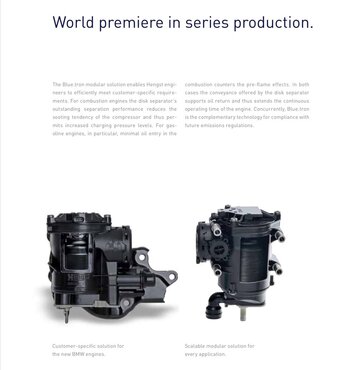The Grenadier Forum
Register a free account today to become a member! Once signed in, you'll be able to contribute to the community by adding your own topics, posts, and connect with other members through your own private inbox! INEOS Agents, Dealers or Commercial vendors please contact admin@theineosforum.com for a commercial account.
You are using an out of date browser. It may not display this or other websites correctly.
You should upgrade or use an alternative browser.
You should upgrade or use an alternative browser.
Catch Can
- Thread starter CountyV8
- Start date
From the Hengst website:
The active crankcase ventilation offer high-efficiency oil separation and active blow-by boost for crankcase ventilation. Reduction of the oil input in the engine intake system enables a higher charge air pressure level, which can be utilized to boost engine performance and efficiency.
The active crankcase ventilation offer high-efficiency oil separation and active blow-by boost for crankcase ventilation. Reduction of the oil input in the engine intake system enables a higher charge air pressure level, which can be utilized to boost engine performance and efficiency.
- Local time
- 8:50 PM
- Joined
- Jul 27, 2022
- Messages
- 6,005
- Local time
- 8:50 PM
- Joined
- Jul 27, 2022
- Messages
- 6,005
Great image of the Hengst active oil mist separator (bottom left), do we know if there's any maintenance required for this? draining?

I was tempted to unscrew the lid and see, but I'm not certain there's anything to maintain. It looks like a sealed system but I wonder if it does get clogged with gunk over time?
Centrifugal oil separator, be interested to see how this extends oil life. Unfortunately we don't have a base line to compare, but I'd like to do an oil analysis when it comes to the service interval.
Wonder what the service life of these are?
Wonder what the service life of these are?
- Local time
- 8:50 PM
- Joined
- Jul 27, 2022
- Messages
- 6,005
I've sent an email to Hengst asking a few questions - I'll post any answers I get.Centrifugal oil separator, be interested to see how this extends oil life. Unfortunately we don't have a base line to compare, but I'd like to do an oil analysis when it comes to the service interval.
Wonder what the service life of these are?
- Local time
- 8:50 PM
- Joined
- Jul 27, 2022
- Messages
- 6,005
So I made a slight typo when I wrote to Hengst and said I had one of their bits of kit attached to my M57 engine. 
What I asked:
"I have the BMW M57 diesel engine installed in an Ineos Grenadier. It's fitted with a Hengst active crankcase ventilation system.
Can you advise on whether this is a standard version, or has been revised for this particular installation?
Are there any servicable parts or routine maintenance requirements for it?"
The reply I got:
"It is quite interesting that you equipped an M57 engine with our disk separator made for the B57 engine.
This separator is not made for any type of service – it lasts for the complete life of a vehicle (> 300.000 km).
One question from my side: if you feed power to the disk separator do you also use the LIN bus signals to control the speed of the system or do you drive it in fail safe mode?
All the best to you and please come back to me, whenever you any question about our product."
What I asked:
"I have the BMW M57 diesel engine installed in an Ineos Grenadier. It's fitted with a Hengst active crankcase ventilation system.
Can you advise on whether this is a standard version, or has been revised for this particular installation?
Are there any servicable parts or routine maintenance requirements for it?"
The reply I got:
"It is quite interesting that you equipped an M57 engine with our disk separator made for the B57 engine.
This separator is not made for any type of service – it lasts for the complete life of a vehicle (> 300.000 km).
One question from my side: if you feed power to the disk separator do you also use the LIN bus signals to control the speed of the system or do you drive it in fail safe mode?
All the best to you and please come back to me, whenever you any question about our product."
What a journey,
My oldest car is from 1971. The crankcase ventilation just evacuates the vapour into the atmosphere. The somewhat younger ones already used a closed system with an oil separator. In out youngest cars the engines need an exactly controled valve. Audi had once a problem killing the turbo (I guess it was the 2,5 l Turbo in the 90s ?? or early 20s), where a change in the angle of the connection pipe turbo to oil sump led to broken turbos. They needed to adjust the crank case pressure about 0,06 bar to get that fixed (the problem was not an immediate fail, but over time the turbo died because of an oil problem). I even didn't know that you can be so granular in an engine, where you can think the hell was started, when it starts to rev.
AWo
My oldest car is from 1971. The crankcase ventilation just evacuates the vapour into the atmosphere. The somewhat younger ones already used a closed system with an oil separator. In out youngest cars the engines need an exactly controled valve. Audi had once a problem killing the turbo (I guess it was the 2,5 l Turbo in the 90s ?? or early 20s), where a change in the angle of the connection pipe turbo to oil sump led to broken turbos. They needed to adjust the crank case pressure about 0,06 bar to get that fixed (the problem was not an immediate fail, but over time the turbo died because of an oil problem). I even didn't know that you can be so granular in an engine, where you can think the hell was started, when it starts to rev.
AWo
@globalgregors posted an excellent BMW education and training document as a pdf file last year which provides detailed info. on the B57 and B58 engines including the unique turbo manifold.
Search B57 engine training document ...I'm sending this from my phone so I regret I'm unable to post the direct link.
LATE EDIT Here you go: https://www.theineosforum.com/threads/b57-b58-product-information-technical-training.12410509/
Search B57 engine training document ...I'm sending this from my phone so I regret I'm unable to post the direct link.
LATE EDIT Here you go: https://www.theineosforum.com/threads/b57-b58-product-information-technical-training.12410509/
Last edited:
Man, I am looking forward to the Grenadier but seeing those pictures with all that plastic brings back horrible memories of my E39 540 having a nearly mandatory 40k mile radiator and overflow tank preventative replacement schedule due to the failing plastic parts! Ugghhh.
Yes, I miss the days of brazed metal radiators.Man, I am looking forward to the Grenadier but seeing those pictures with all that plastic brings back horrible memories of my E39 540 having a nearly mandatory 40k mile radiator and overflow tank preventative replacement schedule due to the failing plastic parts! Ugghhh.
Heck the current M5 has a leaking expansion tank problem.Man, I am looking forward to the Grenadier but seeing those pictures with all that plastic brings back horrible memories of my E39 540 having a nearly mandatory 40k mile radiator and overflow tank preventative replacement schedule due to the failing plastic parts! Ugghhh.
I hope CSF will make some Grenadier specific radiators. They already make some things for B58 equipped BMW vehicles including an improved intake manifold/charge air cooler.
Chinese plasticMan, I am looking forward to the Grenadier but seeing those pictures with all that plastic brings back horrible memories of my E39 540 having a nearly mandatory 40k mile radiator and overflow tank preventative replacement schedule due to the failing plastic parts! Ugghhh.
I have had my current vehicle since May 2018 and I have never seen the radiator.Yes, I miss the days of brazed metal radiators.
I can't recall the last vehicle I looked at the radiator on.
Maybe a Suzuki Sierra back in 2004
And...Yes, I miss the days of brazed metal radiators.
...metel oil pan
...cast iron manifold (not that rusting air gap types which kill your turbo)
...cast iron intake
...metal valve cover
...injectors not going through the valve cover
...metal camshaft gears
Just to nam ea few...
The best engines were build in the nineties.
Uh, sorry, I got sentimental...
AWo
Similar threads
- Replies
- 4
- Views
- 261
Independent Event
UPCOMING OVERLAND EXPO SOCAL IN COSTA MESA, CA / MARCH 15th & 16th 2025
- Replies
- 27
- Views
- 1K




